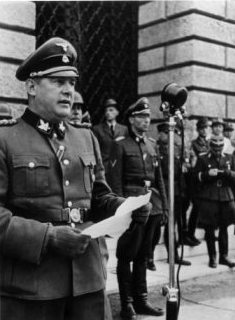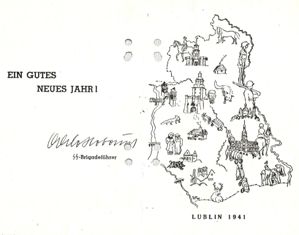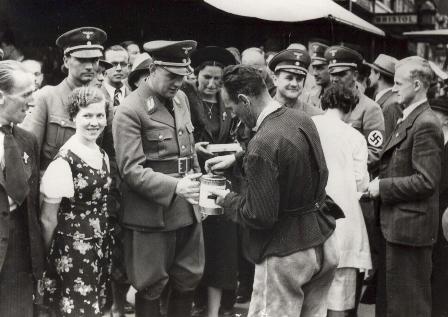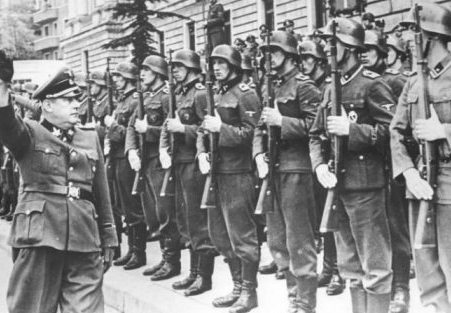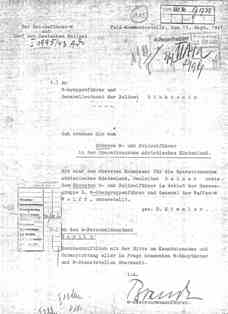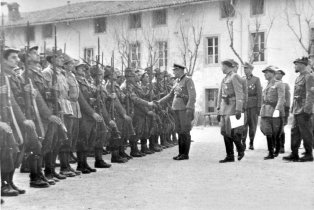Holocaust Education & Archive Research Team |
Aktion Reinhard
A-R Leadership A-R Articles
Action Erntefest Modern Research
| ||||
Odilo Globocnik “The Worst Man in the World”
Odilo Globocnik was born in Trieste on 21 April 1904 he was the son of an Austrian/Slovenian family of petty officials and was a builder by profession.
He joined the Nazi Party in Carinthia Austria in 1930 and became a “radical” leader of its factory cells in the province. In 1933 Globocnik joined the SS and was appointed deputy district leader of the NSDAP in Austria.
He was imprisoned for over a year for a number of political offences, he may have even murdered the Jewish jeweller Futterweiss. Globocnik re-emerged as a key liaison man between Hitler and the Austrian National Socialists, he was appointed provincial Nazi chief of Carinthia in 1936, and subsequently he was promoted to Gauleiter of Vienna on 24 May 1938.
But his decline was soon at; Globocnik was using an astonishing number of dirty tricks, particularly in financial matters. Another was that he was an absolutely uncompromising person who was extremely successful in finding new opponents and enemies in the party ranks, mainly in the Catholic wing of the NSDAP.
A major factor was the fact that Hermann Göring (ReichsMarshall) endeavoured to have Globocnik removed from his high party office. On January 30, 1939, Globocnik was suspended as a Gauleiter and replaced by Josef Burckel.
Globocnik was pardoned by Himmler and appointed on 9 November 1939 as SS and Police Leader for the Lublin district in Poland. Globocnik was a brutal police commander who not only waged a terrible war on Polish Jewry, but who carried out drastic population expulsions in the Zamosc Lands, to germanise the Lublin area.
He was chosen by Himmler as the central figure in Operation Reinhard – named after Reinhard Heydrich, no doubt because of his scandalous past record and well-known virulent anti-semitism.
Put in charge of a special company of SS men not subordinate to any higher authority and responsible only to Himmler, Globocnik founded three death camps as part of Aktion Reinhard, and one combined death camp and concentration camp Majdanek (Lublin).
Globocnik drew rich rewards from the slaughter of 1.7 million Jews whose property ranging from their houses and valuables down to the gold in their teeth was seized by the SS.
As Globocnik’s Summary Reports show, he carried out Himmler’s orders with brutal efficiency and by November 1943 Operation Reinhard had been completed and the three death camps directly under his control were liquidated.
Aktion Reinhard had consisted of four separate tasks:
According to Globocnik’s final accounts to Himmler, the overall value of the cash and valuables accruing to the Reich between 1 April and 15 December 1943 from Operation Reinhard came to approximately 180 million Reichsmarks.
For helping himself too liberally to some of this plunder, Globocnik was promoted to Trieste, together with a number of the “Aktion Reinhard Kommando”, to the post of Higher SS and Police Leader Adriatic Region.
At the end of the war, Globocnik succeeded in evading arrest by returning to his native country in the mountains south of Klagenfurt.
He was eventually tracked down and arrested by a British patrol on 31 May 1945 at Weissensee, Carinthia, and committing suicide by swallowing a cyanide capsule, after the arresting officer Captain Ramsay, shouted his name across the courtyard, and Globocnik slightly turned his head.
A photograph of the dying Globocnik was taken by a German –born sergeant interpreter, who wanted a memento of “the worst man in the world.”
Sources:
Who’s Who in Nazi Germany by Robert S Wistrich published by Routledge, London and New York 1995. The Final Solution by G. Reitlinger, published by Vallentine and Mitchell 1953. Hitler’s Man in the East – Odilo Globocnik by Joseph Poprzeczny, published by McFarland and Company Inc 2004
Copyright CW/CL H.E.A.R.T 2007
|
